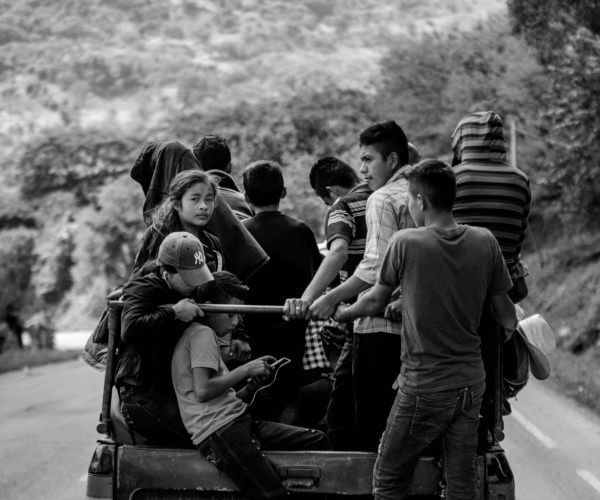The Ones Who Stay
![]()
First place, “News Feature Photo Essay,” Los Angeles Press Club’s 2023 SoCal Journalism Awards.
Judges’ note: Really solid photo essay with a good mix of landscape and people which shows both the physical devastation of war and the human cost.
Click on any photo in the essay to access the full gallery.
After months of provoking its neighbor, Russia invaded the sovereign state of Ukraine on February 24, 2022, sparking an immediate humanitarian crisis and a flood of refugees into Slovakia, Moldova, Hungary, but mostly Poland. Five weeks later, I was on a plane out of JFK International Airport, heading toward Poland.
My previous work — documenting refugees in Central America for the past seven years — influenced my decision to travel to Ukraine. This is what I carried in my mind upon arriving in Poland, where I was immediately struck by how swiftly countries surrounding Ukraine opened their borders and granted asylum. This was in sharp contrast to the reluctant, slow and prodding process of granting refugees entrance into the United States from the Mexican border.
Nikola and his friend, in front of their Bucha apartment complex, which was destroyed by a Russian missile.
Bombed apartment complex in Bucha, where thousands of war crimes by Russian soldiers have been reported.
Oleksiy was left homeless after his apartment was destroyed by Russian forces in Bucha.
My first destination was Przemyśl, Poland. Little did I know the extent of the embrace that Ukraine’s neighbor undertook to welcome the refugees. In Poland, the refugees were treated with the utmost kindness upon arrival, often receiving free coffee or meals and access to free train trips to anywhere they wanted in Europe.
In Medyka, Poland, one of the busiest border crossings in Poland, an extensive network of international volunteers aid the thousands of Ukrainian refugees fleeing the war.
I began my Ukrainian journey in Lviv. I boarded a train leaving Przemyśl at 3:00 p.m. on April 2nd. In order to take my seat, I had to walk down a stairway to reach customs and climb back up. The stairs were dark and empty. I felt a pain in my stomach.
As I found my seat, I was handed pillows and blankets. A man in his late 50s, tall and heavyset, was sitting in front of me. Igor spoke very little English, just enough to chat with. A mechanical engineer by trade, he taught me my first lesson in the Ukrainian language: picture, yes, thank you and please. These few basic words would prove incredibly useful to me during my journey. He also showed me the first of many kindnesses locals would bestow upon me in the coming weeks as he shared his water and allowed me to recharge my phone using his external battery.
Seven and a half hours later, I arrived in Lviv at 10:30 p.m. Ukraine’s nightly curfew is set for 9:00 p.m. I didn’t have a place to stay, nor any contacts in town. The station was filled with armed soldiers. I was planning to sleep there and find a hotel the following morning when the curfew was lifted. However, a guard warned me press members were not allowed to stay there overnight and escorted me outside to the Help Center. After showing my passport and press credentials, I was taken by car to a hotel in the center of town. Everything was dark. I entered the lobby, someone handed me a room key and I took the elevator to the fifth floor. The lights were out and I had to pay cash. Thankfully, I had changed money in Poland before leaving for Ukraine.
Lviv is a beautiful city. I was struck by its charm and how much it reminded me of Paris. The streets were made lively by musicians, and there was a flow of people strolling or dining out. But this illusion of normalcy was shattered the first time I heard the howl of a public alarm sounding in the middle of the day. My heart stopped. I became disoriented and did not know what was happening. I thought we were being attacked. Later, someone explained to me that the alarms signal that a missile had been fired from Russia into Ukraine.
I made my way to the Lviv Media Center, where I was issued a Ukrainian Press Pass, a helmet and a level-7 bullet-proof vest. At the Media Center, I also obtained the military accreditation that allowed me to travel into Kyiv and further inside the country.
Rescue team in Bucha digs through the rubble after Russian missile attacks targeting homes and public buildings.
Empty Russian munitions boxes left after massive attacks in Bucha. There is much-unexploded ordnance scattered throughout districts in and around Kyiv and throughout Ukraine.
In Bucha, collecting dead bodies has taken a toll on the military, so volunteers have started to share this heavy load. Here, a volunteer takes a break in between transporting bodies from the streets to burial locations.
Soldiers on the highway to Irpin, Ukraine.
Remarkably, I had the good fortune to meet a group of Mexican freelance photojournalists — Eduardo Quiroz, Cristopher Rogel Blanquet and David Peinado — who hailed from my hometown of Juárez, Mexico. They were kind enough to invite me to join their group heading into Kyiv. Initially, I had planned to limit my stay to Lviv, but with the support of my newfound friends, I found the courage to take the journey further. The following day we took a night train out of the city, arriving in Kyiv the following morning at 7 a.m.
From that point on, the four of us would share a one-bedroom apartment previously occupied by a friend of Rogel’s who had hastily left for Mexico City the day Kyiv was first attacked. The 19th-floor apartment was messy with dirty dishes left in the sink and personal belongings strewn all over the floor. Clearly, Rogel’s friend and his partner had literally escaped from Kyiv. This apartment became the hub from which we ventured out on day treks into Irpin, Bucha and Chernihiv — cities which faced the heaviest damage from the Russian offensive.
Bombed apartment complex in Bucha, where residences were abandoned hastily, leaving behind evidence of the peaceful lives led immediately before evacuation.
In Bucha, I understood that there were two segments of the population that most desperately needed humanitarian help: its senior citizens who could not — or would not — leave their city, and the packs of dogs made ravenous by hunger. They were strangely and disturbingly connected by the crisis. The dogs would roam together in search of food, sometimes resulting in attacks on the most vulnerable of elders, who could only try to fend them off with their walking sticks.
Traversing those war-torn streets, I would see people cooking outside on portable gas stoves or campfires. They would often beckon to me with their hands, drawing them to their mouths and asking if I was hungry and needed nourishment. I was comforted that even in the midst of all the pain, suffering and violence, kindness like this could still be found.
Civilians walking through what is left of Bucha. Stray dogs follow those who have stayed behind, searching for food and companionship.
Ira in Irpín, Ukraine (near Kyiv) after Russian forces left the city. 70 percent of Irpin has been destroyed by Russian attacks.
Olga’s friends and neighbors prepare what food they can on their makeshift stove.
Olga, who was displaced onto the streets of Bucha after her house was destroyed, shares bread and borscht. Olga and her friends offered food, conversation and warmth despite their devastating circumstances.
Bodies are still being found after the massacre in Bucha. There are no more spaces in the city’s cemetery for proper burials, so bodies are starting to be buried in people’s backyards.
As I had done at the US-Mexico borderlands over the past seven years, to more fully convey the plight of refugees, I decided to journey back into Poland with them.
Making my way around those tents where food was being offered to Ukrainian refugees, I was grateful that the larger free world was making itself present and expressing its solidarity for the Ukrainian people in the face of Russian invasion.
On April 11th, I boarded a bus from Lviv into Medyka, Poland. Every available seat was occupied by women and children fleeing the conflict. When we arrived at the border, we were held on the bus for four hours awaiting inspection and processing. As we set foot in Poland, we were greeted by the sight of mobile kitchens staffed by volunteers from an array of European countries — including Italy, Norway and Germany — as well as Asian nations and the Indian subcontinent. Making my way around those tents where food was being offered to Ukrainian refugees, I was grateful that the larger free world was making itself present and expressing its solidarity for the Ukrainian people in the face of Russian invasion.
Click here to view Ada Trillo’s “The Ones Who Stay” photo essay.
Help us sustain independent journalism...
Our team is working hard every day to bring you compelling, carefully-crafted pieces that shed light on the pressing issues of our time. We rely on caring supporters like you to help us sustain our mission. Your support ensures that we can continue to provide deeply-reported, independent, ad-free journalism without fear, favor or pandering. Support us today and make a lasting investment in the future.

















































